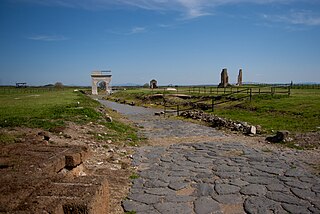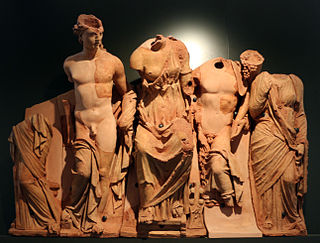
The Centaur of Vulci is a statue of the Etruscan Orientalising period, discovered in Vulci near Etruscan Viterbo, now in the collection of the National Etruscan Museum of Villa Giulia in Rome. [1]

The Centaur of Vulci is a statue of the Etruscan Orientalising period, discovered in Vulci near Etruscan Viterbo, now in the collection of the National Etruscan Museum of Villa Giulia in Rome. [1]
The statue was discovered in a private tomb in the necropolis of Poggio Maremma in Vulci Archaeological Park.
This nenfro statue dates from 590 to 580 BC. It represents a centaur, a character from Greek mythology with a human torso and a horse's body.
The head, with an incised beard and hair falling into three braids on the upper legs, gives way to a brief chest and an equine body which lacks a tail. The arms are missing and also the legs below the knees; hands are visible on the hips. [2]

The Villa Giulia is a villa in Rome, Italy. It was built by Pope Julius III in 1551–1553 on what was then the edge of the city. Today it is publicly owned, and houses the Museo Nazionale Etrusco, a collection of Etruscan art and artifacts.

The Loggia dei Lanzi, also called the Loggia della Signoria, is a building on a corner of the Piazza della Signoria in Florence, Italy, adjoining the Uffizi Gallery. It consists of wide arches open to the street. The arches rest on clustered pilasters with Corinthian capitals. The wide arches appealed so much to the Florentines that Michelangelo proposed that they should be continued all around the Piazza della Signoria.

An antefix is a vertical block which terminates and conceals the covering tiles of a tiled roof. It also serves to protect the join from the elements. In grand buildings, the face of each stone antefix was richly carved, often with the anthemion ornament. In less grand buildings moulded ceramic antefixes, usually terracotta, might be decorated with figures heads, either of humans, mythological creatures, or astrological iconography, especially in the Roman period. On temple roofs, maenads and satyrs were often alternated. The frightening features of the Gorgon, with its petrifying eyes and sharp teeth was also a popular motif to ward off evil. A Roman example from the Augustan period features the butting heads of two billy goats. It may have had special significance in imperial Rome since the constellation Capricorn was adopted by the emperor Augustus as his own lucky star sign and appeared on coins and legionary standards. By this time they were found on many large buildings, including private houses. The earliest examples in museum collections date back to the 7th century BCE in both Greece and Etruria.

Vulci or Volci was a rich Etruscan city in what is now northern Lazio, central Italy.

The sanctuary of Minerva at Portonaccio is an archaeological site on the western side of the plateau on which the ancient Etruscan city of Veii, north of Rome, Italy, was located. The site takes its name from the locality within the village of Isola Farnese, part of Municipio XX, city of Rome.

The Chimera of Arezzo is regarded as the best example of ancient Etruscan art. The British art historian David Ekserdjian described the sculpture as "one of the most arresting of all animal sculptures and the supreme masterpiece of Etruscan bronze-casting". Made entirely of bronze and measuring 78.5 cm high with a length of 129 cm, it was found alongside a small collection of other bronze statues in Arezzo, an ancient Etruscan and Roman city in Tuscany. The statue was originally part of a larger sculptural group representing a fight between a Chimera and the Greek hero Bellerophon. This sculpture is likely to have been created as a votive offering to the Etruscan god Tinia.
Giulio Quirino Giglioli was an art historian of classical Roman and Etruscan art and was associated with Fascism in Italy.

The Sarcophagus of the Spouses is a tomb effigy considered one of the masterpieces of Etruscan art. The Etruscans lived in Italy between two main rivers, the Arno and the Tiber, and were in contact with the Ancient Greeks through trade, mainly during the Orientalizing and Archaic Period. The Etruscans were well known for their terracotta sculptures and funerary art, largely sarcophagi and urns. The sarcophagus is a late sixth-century BCE Etruscan anthropoid sarcophagus that was found at the Banditaccia necropolis in Caere and is now located in the National Etruscan Museum of Villa Giulia, Rome.

The National Etruscan Museum is a museum of the Etruscan civilization, housed in the Villa Giulia in Rome, Italy.

Etruscan art was produced by the Etruscan civilization in central Italy between the 10th and 1st centuries BC. From around 750 BC it was heavily influenced by Greek art, which was imported by the Etruscans, but always retained distinct characteristics. Particularly strong in this tradition were figurative sculpture in terracotta, wall-painting and metalworking especially in bronze. Jewellery and engraved gems of high quality were produced.

The François Tomb is an important painted Etruscan tomb from the Ponte Rotto Necropolis in the Etruscan city of Vulci, Lazio, in central Italy. It was discovered in 1857 by Alessandro François and Adolphe Noël des Vergers. It dates to the last quarter of the fourth century BC. The tomb seems to belong to the Etruscan family of the Saties and one of its chief occupants is Vel Saties, who appears with his dwarf, Arnza.

The Three Revelers Vase, also known as simply the Revelers Vase, is a Greek vase originating from the Archaic Period. Painted around 510 BCE in the red figure pottery style, the Revelers vase was found in an Etruscan tomb in Vulci, Italy. The painting is attributed to Euthymides. Although the vase is in the amphora shape, its purpose is more decorative than functional. The painting itself shows three nude partygoers and Hector arming on the reverse. The work is remarkable because of the early use of foreshortening as opposed to conventional profile and frontal views. The Revelers Vase currently resides in the Staatliche Antikensammlungen in Münich, Germany.

A Caeretan hydria is a type of ancient Greek painted vase, belonging to the black-figure style.

The Isis Tomb is a richly endowed Etruscan chamber tomb that was found at the Polledrara Cemetery, Vulci, Lazio, Italy, in the early nineteenth century. Many artefacts were discovered in the Isis Tomb when it was originally excavated but, as was custom at the time, only objects of high monetary value were kept. Over 60 of these objects are now held by the British Museum, with others scattered across a range of museums around the world.

Nenfro is a volcanic rock, gray tuff or banded trachyte (Brocchi) or leucite phonolite lava (Rosenbusch) with a soft but compact structure, typical of the Viterbo region that the Etruscans used in their sculptures of northern Lazio Cimini hills near Rome, Italy.

Set of jewelry, also known as the Vulci group is a set of 5th century BCE Etruscan metalwork collection by an unknown jeweler. It is in the collection of the Metropolitan Museum of Art.

The Winged Lion of Vulci is a nenfro sculpture of a lion with wings, carved between 550 BC and 540 BC and discovered in excavations of the necropoli of the Etruscan city of Vulci. It is now in the Louvre.
Alessandro François (1796–1857) was an Italian archaeologist. He was also a scholar, artist, engineer, and war commissioner of the Grand Duke of Tuscany in the mid-19th century.

Etruscan sculpture was one of the most important artistic expressions of the Etruscan people, who inhabited the regions of Northern Italy and Central Italy between about the 9th century BC and the 1st century BC. Etruscan art was largely a derivation of Greek art, although developed with many characteristics of its own. Given the almost total lack of Etruscan written documents, a problem compounded by the paucity of information on their language—still largely undeciphered—it is in their art that the keys to the reconstruction of their history are to be found, although Greek and Roman chronicles are also of great help. Like its culture in general, Etruscan sculpture has many obscure aspects for scholars, being the subject of controversy and forcing them to propose their interpretations always tentatively, but the consensus is that it was part of the most important and original legacy of Italian art and even contributed significantly to the initial formation of the artistic traditions of ancient Rome. The view of Etruscan sculpture as a homogeneous whole is erroneous, there being important variations, both regional and temporal.

Daily life among the Etruscans is difficult to trace, as few literary testimonies are available and Etruscan historiography was highly controversial in the 19th century.